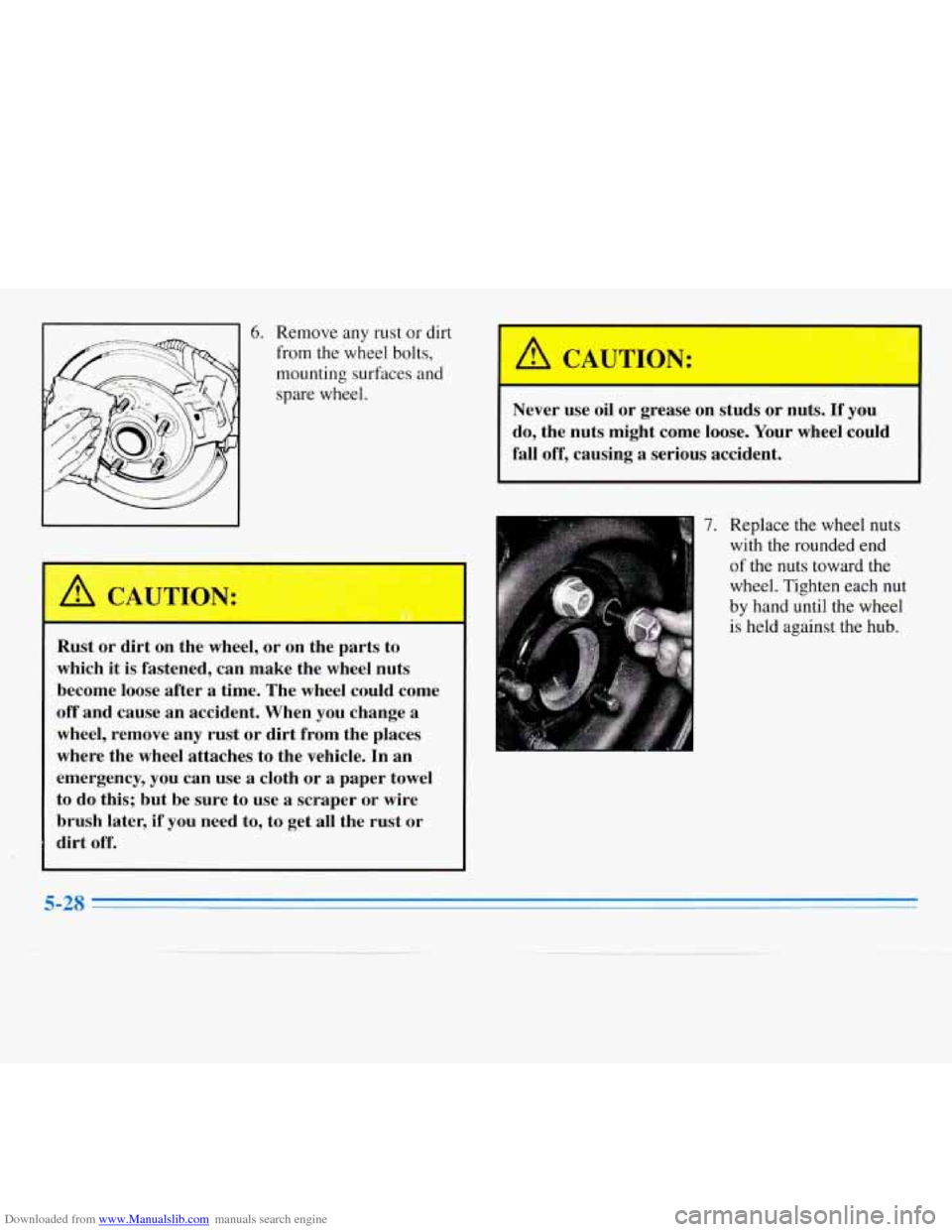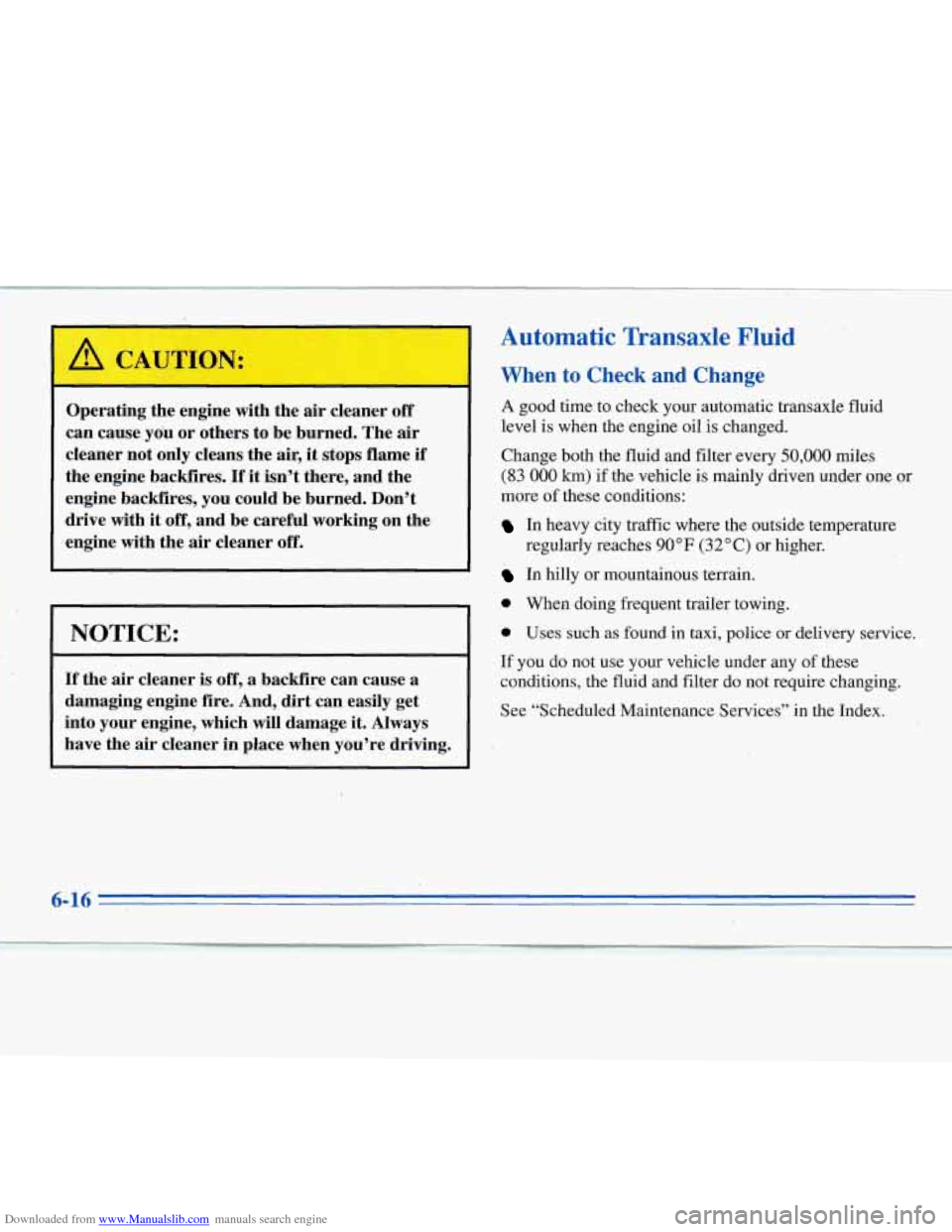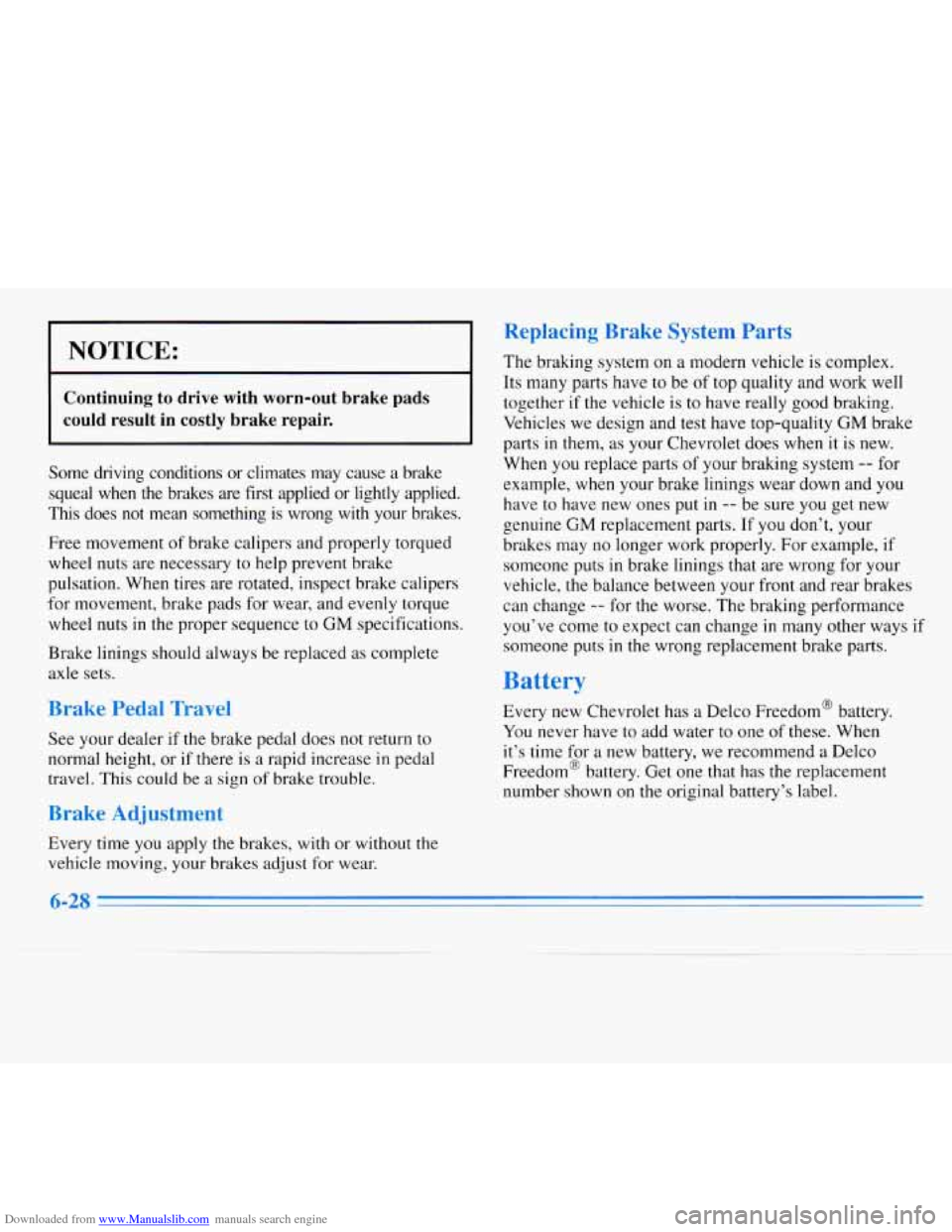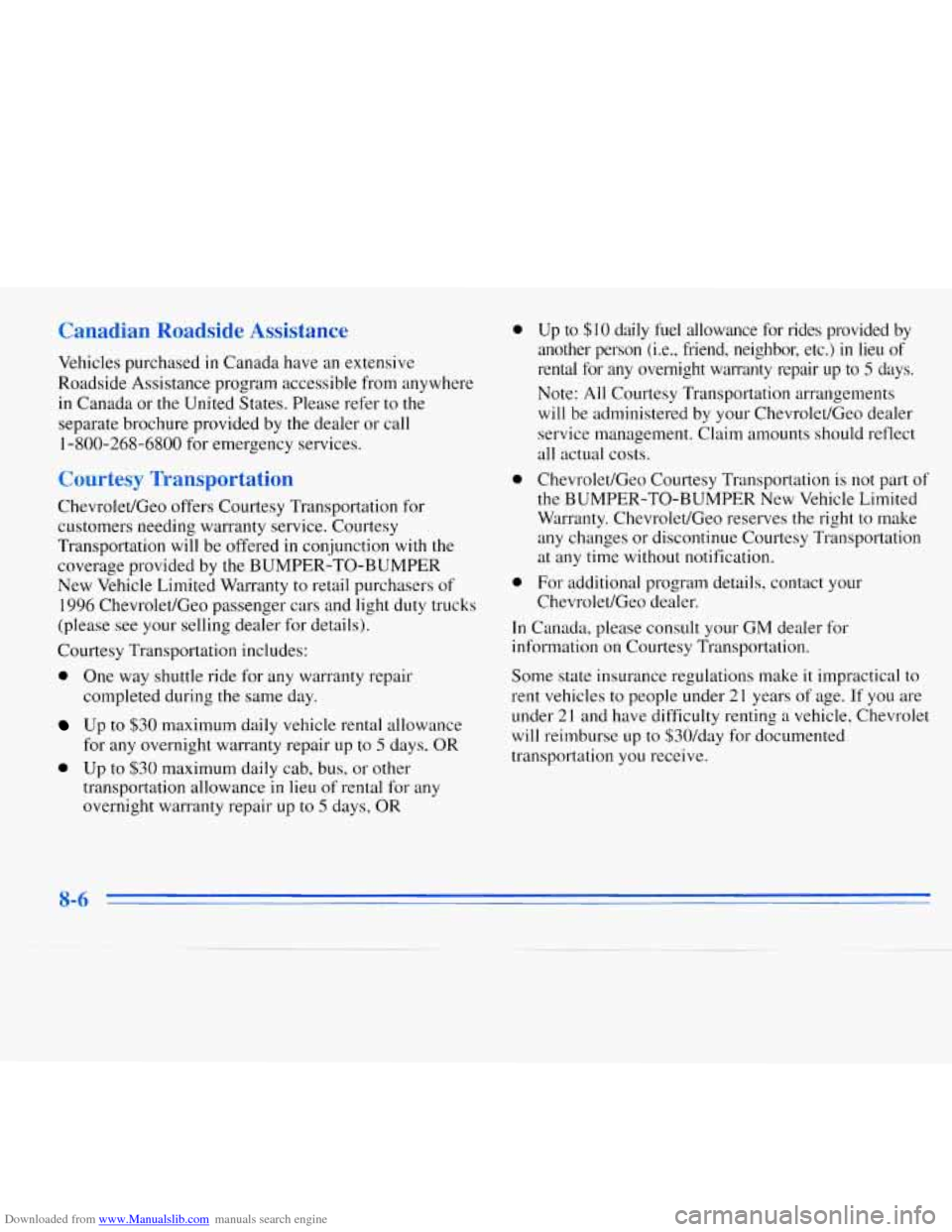1996 CHEVROLET MONTE CARLO change time
[x] Cancel search: change timePage 200 of 340

Downloaded from www.Manualslib.com manuals search engine L
6. Remove any rust or dirt
from the wheel bolts,
mounting surfaces and
spare wheel.
Rust or dirt on the wheel, or on the parts to
which it
is fastened, can make the wheel nuts
become loose after
a time. The wheel could come
off and cause an accident. When you change
a
wheel, remove any rust or dirt from the places
where the wheel attaches to the vehicle. In an
emergency, you can use a cloth or a paper towel
to do this; but be sure to use a scraper or wire
brush later,
if you need to, to get all the rust or
dirt off.
,- , ,. ,.
Never use oil or grease on studs or nuts. If you
do, the nuts might come loose. Your wheel could
fall off, causing a serious accident.
7. Replace the wheel nuts
with the rounded end
of the nuts toward the
wheel. Tighten each
nut
by hand until the wheel
is held against the
hub.
5-28
Page 224 of 340

Downloaded from www.Manualslib.com manuals search engine -
,A CAUTION:
Operating the engine with the air cleaner off
can cause you or others to be burned. The air
cleaner not only cleans the air, it stops flame if
the engine backfires. If it isn’t there, and the
engine backfires, you could be burned. Don’t
drive with
it off, and be careful working on the
engine with the
air cleaner off.
NOTICE:
If the air cleaner is off, a backfire can cause a
damaging engine fire. And, dirt can easily get
into your engine, which will damage it. Always
have the air cleaner in place when you’re driving.
Automatic Transaxle Fluid
When to Check and Change
A good time to check your automatic transaxle fluid
level is when the engine oil is changed.
Change both the fluid and filter every
50,000 miles
(83 000 km) if the vehicle is mainly driven under one or
more
of these conditions:
In heavy city traffic where the outside temperature
In hilly or mountainous terrain.
0 When doing frequent trailer towing.
0 Uses such as found in taxi, police or delivery service.
If you do not use your vehicle under any of these
conditions, the fluid and filter do not require changing.
See “Scheduled Maintenance Services’’ in the Index.
regularly reaches
90°F (32°C) or
higher.
6-16 .
Page 236 of 340

Downloaded from www.Manualslib.com manuals search engine I NOTICE:
Continuing to drive with worn-out brake pads
could result in costly brake repair.
Some driving conditions or climates may cause a brake
squeal when the brakes are first applied or lightly applied.
This does
not mean something is wrong with your brakes.
Free movement
of brake calipers and properly torqued
wheel nuts are necessary to help prevent brake
pulsation. When tires are rotated, inspect brake calipers
for movement, brake pads for wear, and evenly torque
wheel nuts in the proper sequence to
GM specifications.
Brake linings should always be replaced
as complete
axle sets.
Brake Pedal Travel
See your dealer if the brake pedal does not return to
normal height, or if there is a rapid increase
in pedal
travel. This could be
a sign of brake trouble.
Brake Adjustment
Every time you apply the brakes, with or without the
vehicle moving, your brakes adjust for wear.
Replacing Brake System Parts
The braking system on a modern vehicle is complex.
Its many parts have to be
of top quality and work well
together
if the vehicle is to have really good braking.
Vehicles we design and test have top-quality
GM brake
parts in them,
as your Chevrolet does when it is new.
When you replace parts
of your braking system -- for
example, when your brake linings wear down and you
have to have new ones put
in -- be sure you get new
genuine
GM replacement parts. If you don’t, your
brakes may no longer work properly. For example, if
someone puts in brake linings that are wrong for your
vehicle, the balance between your front and rear brakes
can change
-- for the worse. The braking performance
you’ve come to expect can change in many other ways
if
someone puts in the wrong replacement brake parts.
Battery
Every new Chevrolet has a Delco Freedom@ battery.
You never have to add water to one
of these. When
it’s time for
a new battery, we recommend a Delco
Freedom@ battery. Get one
that has the replacement
number shown on the original battery’s label.
6-28
Page 247 of 340

Downloaded from www.Manualslib.com manuals search engine After the tires have been rotated, adjust the front and
rear inflation pressures as shown on the Tire-Loading
Information label. Make certain that all wheel nuts are properly tightened. See “Wheel Nut Torque” in
I1 the Index.
I
When It’s Time for New Tires
(
Rust or dirt on a wheel, or on the parts to which
it is fastened, can make wheel nuts become loose
after
a time. The wheel could come off and cause
an accident. When you change a wheel, remove
any rust or
dirt from places where the wheel
attaches to the vehicle. In an emergency, you can
use a cloth or a paper towel to do this; but be
sure to use a scraper
or wire brush later, if you
need to, to get all the rust or dirt off. (See
‘(Changing
a Flat Tire? in the Index.)
One way to tell when it’s
time for new tires is to
check the treadwear indicators, which will appear when your tires have
only 1/16 inch (1.6
mm) or
less of tread remaining.
You need a new tire if any of the following statements
are true:
You can see the indicators at three or more places
around the tire.
You can see cord or fabric showing through the
tire’s rubber.
The tread or sidewall is cracked, cut or snagged deep
enough to show cord or fabric.
0 The tire has a bump, bulge or split.
The tire has a puncture, cut or other damage that
can’t be repaired well because of the size or location
of the damage.
6-39
Page 324 of 340

Downloaded from www.Manualslib.com manuals search engine c -nadian Roaa; le mce 0
Vehicles purchased in Canada have an extensive
Roadside Assistance program accessible from anywhere
in Canada or the United States. Please refer to the
separate brochure provided by the dealer or call
1-800-268-6800 for emergency services.
-tesy Transportati
Chevrolet/Geo offers Courtesy Transportation for
customers needing warranty service. Courtesy
Transportation will be offered in conjunction
with the
coverage provided by the BUMPER-TO-BUMPER
New Vehicle Limited Warranty to retail purchasers of
1996 ChevroletIGeo passenger cars and light duty trucks
(please see your selling dealer for details).
Courtesy Transportation includes:
0 One way shuttle ride for any warranty repair
completed during the same day.
Up to $30 maximum daily vehicle rental allowance
for any overnight warranty repair
up to 5 days, OR
0 Up to $30 maximum daily cab, bus, or other
transportation allowance in
lieu of rental for any
overnight warranty repair up to
5 days, OR
0
0
Up to $10 daily fuel allowance for rides provided by
another person (i.e., friend, neighbor, etc.)
in lieu of
rental for any overnight warranty repair up to
5 days.
Note: All Courtesy Transportation arrangements
will be administered by your Chevrolet/Geo dealer
service management. Claim amounts should reflect
all actual costs.
Chevrolet/Geo Courtesy Transportation is not part of
the BUMPER-TO-BUMPER New Vehicle Limited
Warranty. Chevrolet/Geo reserves the right to make
any changes or discontinue Courtesy Transportation
at any time without notification.
For additional program details, contact your
Chevrolet/Geo dealer.
In Canada, please consult your GM dealer for
information on Courtesy Transportation.
Some state insurance regulations make
it impractical to
rent vehicles to people under 2
1 years of age. If you are
under
21 and have difficulty renting a vehicle, Chevrolet
will reimburse up to $30/day for documented
transportation you receive.
8-6
Page 337 of 340

Downloaded from www.Manualslib.com manuals search engine Thermostat .................................... 6-23
Tilt Steering Wheel
............................. 2-24
Time. Setting the
................................ 3-5
TireLoading
................................... 4-26
Tire-Loading Information Label
................... 4-26
BuyingNew
................................. 6-40
Tire Chains
.................................... 6-43
Tires
......................................... 6-36
Alignment
and Balance ........................ 6-42
Chains
..................................... 6-43
Changing a Flat
.............................. 5-22
Cleaning
.................................... 6-50
Compact Spare
............................... 5-33
Inflation
.................................... 6-37
Inflation Check
............................... 7-36
Inspection and Rotation
........................ 6-38
Loading
.................................... 4-26
Pressure
.................................... 6-37
Storing the Flat
............................... 5-30
Storing the Spare
............................. 5-32
Temperature
................................. 6-4 I
Traction .................................... 6-41
Treadwear
................................... 6-41
Uniform Quality Grading
....................... 6-40
Wear Indicators
.............................. 6-39
Wheel Replacement
........................... 6-42
When It’s Time for New
....................... 6-39
TopStrap
..................................... 1-33
TorqueLock
................................... 2-20
Torque, Wheel
Nut .............................. 5-29
TowingaTrailer
................................ 4-28
Towing Your Vehicle
............................. 5-7 Trailer
Brakes
Driving
Driving
Hitches
..................................... 4-32
onGrades
............................ 4-33
with ................................. 4-32
..................................... 4-31
Maintenance When Towing
..................... 4-34
Parking on Hills
.............................. 4-34
Safety Chains
................................ 4-31
Tongueweight
............................... 4-30
Total Weight on Tires
.......................... 4-31
Towing
..................................... 4-28
TurnSignals
................................. 4-33
Weight
..................................... 4-30
Transaxle Fluid. Automatic
....................... 6-16
Transmitters. Remote Lock Control
.................. 2-4
Transportation. Courtesy
.......................... 8-6
Trip Odometer
................................. 2-41
Trunk
......................................... 2-6
Lock
........................................ 2-6
Release. Remote
............................... 2-7
TTYUsers ..................................... 8-3
Turn Signal and Lane Change Signals
............... 2-25
Turn Signal/Multifunction Lever
................... 2-24
Turn Signals When Towing
a Trailer ................ 4-33
Underbody Flushin, o Service ..................... 7-39
Underhood Electrical Center
................. 6-56. 6-58
Underbody Maintenance
......................... 6-50
9-9